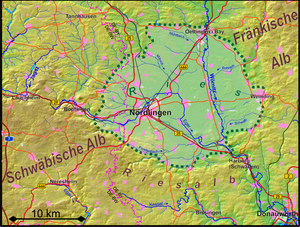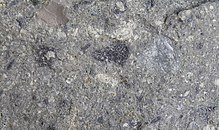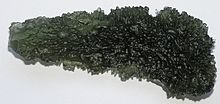Nördlinger Ries
| Ries natural area | |
|---|---|
| State : | Bavaria , Baden-Wuerttemberg |
| Identifier: | 10300 |
| Area : | approx. 348 km² |
| map | |
| location | |
| Coordinates: 48 ° 53 ' N , 10 ° 32' E | |
The Nördlinger Ries is a natural area in the southwestern German stepland and is located in the border area between the Swabian Alb and the Franconian Alb in the triangle between Nuremberg , Stuttgart and Munich . It extends for the most part on the Swabian district of Donau-Ries in Bavaria, a small portion is located in the Baden-Württemberg Ostalbkreis . A small proportion is in the central Franconian district of Weißenburg-Gunzenhausen , also in Bavaria.
It concerns the unit 103 - Ries within the natural spatial main unit D58 - Swabian Keuper-Lias-Land
The almost circular, flat Ries stands out conspicuously from the hilly landscape of the Alb. Due to the rocks found in the Ries , especially suevite , the Ries was initially thought to be a volcanic structure. It was not until 1960 that it could be proven that the remains of an approximately 14.6 million year old impact crater formed during the Ries event . The Ries is one of the best preserved large impact craters on earth .
origin of the name
The name "Ries" is derived from the name of the Roman province " Raetia ", as one entered this province here in Roman times, coming from the west.
Appearance
The Nördlinger Ries is almost circular (diameter about 20–24 kilometers). The area covers an area of 348 km². The crater is clearly visible from the air because of its size and the strong weathering. From the ground, the rim of the crater appears as a forested chain of hills all around the horizon. Today's crater floor, in which there are no major elevations in contrast to the neighboring hilly Alb landscape, is around 100 to 150 meters below the surrounding plateaus of the Swabian - Franconian Alb . The only exception is a ring-shaped chain of hills inside the crater ( Innerer Wall , Innerer Ring or Crystalline Ring ), which characterizes the Nördlinger Ries as a complex impact crater and distinguishes it from simple, "bowl-shaped" craters. Components of the inner ring are, for example, the Marienhöhe near Nördlingen , the Wallersteiner Felsen and the Wennenberg near Alerheim .
There are several cities in the Nördlinger Ries, including Nördlingen , Harburg , Oettingen , Bopfingen and Wemding as the largest . The Wörnitz crosses the shallow Ries basin from north to south in numerous meanders , on the southern edge of the Ries flows the Eger, which drains its west .
View into the Nördlinger Ries from the bladder mountain near Kirchheim am Ries , left in the distance Nördlingen . The wooded hills on the right edge of the picture form the southern edge of the crater.
Formation of the Nördlinger Ries
Early theories
For more than a century, geologists had great difficulty in explaining the origin of the giant and its unusual rocks , as a result of which different interpretations competed over time. Because that occurring in Ries Suevite -Gestein the volcanic tuff is similar, it usually was any volcanic origin adopted. Already Mathias of Flurl , the founder of Geology in Bavaria , the ream of 1805 described as volcanic area . From the distribution of the suevite in 1870, Carl Wilhelm von Gümbel concluded that there was a Ries volcano , which, however, had been completely eroded again in the course of the earth's history, so that only the rocks it had thrown out remained. Wilhelm Branco and Eberhard Fraas tried to explain the lack of a volcano in 1901 by the fact that an ascending, underground magma chamber initially led to an uplift of the subsoil and later, through the penetration of water in several places, explosive evaporation occurred. From 1910 onwards, the officer Walter Kranz showed by means of explosive tests that the phenomena in the Ries can best be explained by a single central explosion. He also assumed that the cause of the explosion was the penetration of water into a magma chamber. Aside from the cause of the explosion, Kranz came very close to the actual mechanism of its origin.
In addition to the volcanic theories, other theories that were supposed to explain the Ries phenomenon were discussed, such as the glacial one, according to which it was a consequence of an earlier glaciation, or the tectonic one , according to which a basin rupture in connection with the formation of the Alps should have been the cause. However, none of these hypotheses could conclusively explain all the peculiarities of the Nördlinger Ries.
As early as 1904, Ernst Werner assumed a meteorite impact was likely to cause the giant to develop. Even Otto Stutzer asked 1,936 similarities between the Meteor Crater in Arizona firm and the ream, but could the impact theory not achieve a breakthrough as well.
Impact theory
The US geologists Eugene Shoemaker and Edward CT Chao were finally able to use rock samples to prove that the crater must actually have been created by a meteorite impact , the so-called Ries event . The evidence was primarily based on the discovery of stishovite and coesite , both high-pressure modifications of quartz , which can only arise under the extreme conditions of a meteorite impact, but not through volcanism .
The meteorite , which produced the Nördlinger Ries 14.6 (± 0.2) million years ago in the Miocene ( Langhium ), is likely to have a diameter of about 1.5 km and a speed of about 15-50 km / s ( this corresponds to 54,000–180,000 km / h). The explosion when the meteorite hit had the energy of several 100,000 Hiroshima bombs . The impact ejected 150 km³ of rock, even parts of the crystalline basement , because the meteorite penetrated the 600 m thick overburden of Mesozoic sedimentary rocks ( limestone , clays ). Individual stones from the ejection were hurled up to 70 km, tektite even up to 450 km. In a few minutes, a crater almost 25 km in diameter and around 500 m deep was created. Almost all life within a radius of at least 100 km was suddenly extinguished.
In the time after the impact, the crater filled with water and became a lake of around 400 km². Salts accumulated in this inland waterway without any drainage , so that the salt content of the resulting salt lake finally exceeded that of today 's oceans . Over the next two million years, the crater lake gradually silted up . It was only during the Ice Ages that today's Rieskessel was exposed by erosion and loess was introduced , which forms the basis for today's agricultural use.
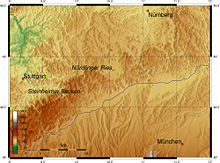
Neighboring event
About 40 km southwest of the Nördlinger Ries lies the Steinheim Basin , another impact crater with a diameter of 3.5 km. It is also around 15 million years old and should go back to the same event as the Ries. According to this, the cosmic body whose impact left the two craters was an asteroid that was accompanied by a smaller satellite .
geology

The Nördlinger Ries is one of the best preserved large impact craters on earth . Especially in the south, southeast and east of the crater, both the crater rim and the rocks ejected from the crater (ejecta cover) are still relatively well preserved. The Ries therefore plays an important role in the exploration of earthly impact craters. Even the astronauts on NASA's Apollo 14 mission completed geological training here from August 10th to 14th, 1970 before the moon landing. Under the direction of the Tübingen geologists Wolf von Engelhardt , Dieter Stöffler and Günther Graup , they were made familiar with the features and rocks of a meteorite crater.
On June 29, 1973, the Nördlingen research well (FBN) started on a property in Löpsingen . The drilling was completed on January 15, 1974 at a depth of 1206 m. Essentially three layers were drilled: lake sediments up to 325 m, suevite up to 606 m and shattered bedrock up to 1206 m.
In 2002, three geotopes in the Nördlinger Ries were awarded the official seal of approval "Bavaria's most beautiful geotopes" by the Bavarian Ministry of the Environment: The rubble rocks of Wengenhausen , the Schwabenstein near Aumühle and the Riesseekalke in Hainsfarth . In 2006, the Nördlinger Ries was included in the list of 77 awarded national geotopes in Germany.
Crystalline breccias
Within the rim of the crater there is a second, ring-shaped chain of hills in the Ries, the so-called Inner Wall . The base of these mounds consists of breccias made of granite and other igneous rocks that are so badly shattered that they often crumble into sand when excavated . Cones of rays that were formed when the shock wave passed through the rock after the meteorite impact can also occasionally be found. The inner ring is created by the spring back of the bedrock after the meteorite impact, similar to a central mountain known from other craters such as the Steinheim Basin . Normally, the crystalline basement can only be found 300 to 400 m deeper if stored undisturbed outside the crater. Since this wall contains crystalline material, it is also known as a crystalline ring .
Colorful masses of debris
The “ colorful rubble masses ” form the main ejection mass of the Ries crater. They were ejected from the crater by the explosive evaporation of the meteorite upon impact and were often thrown for kilometers through the air ( ballistic ejection) or pushed outwards over the surface. The debris consists mainly of Mesozoic sedimentary rocks from different stratigraphic layers that are found mixed up at random. Originally the 'colorful rubble masses' formed a closed ejecta cover up to a distance of 40 km around the Ries, which was up to 100 m thick.
Suevite

The Suevite , which is characteristic of the Ries impact rock , contains thermally altered sedimentary rocks and solidified melt some minerals that occur only at extremely high pressures and temperatures,. B. stishovite , coesite and diaplectic glasses . Drilling in the Ries has shown that the Ries crater is filled with suevite up to 400 meters high. Isolated occurrences of suevite outside the crater are always on top of the 'colorful debris'. From this it can be concluded that the suevite from the glowing cloud of the impact that rose above the crater was deposited after the ejection of the debris from the crater was completed.
Reuter blocks
The so-called Reuter's blocks , hundredweight partly Jura - limestone chunks were ejected at high speed from the crater and flew up to 70 km. They are still found today around Augsburg and Ulm . They may have been accelerated by expanding, hot gases from the central explosion as they were ejected. They are named after the Munich geologist Lothar Reuter , who mapped the distribution of these blocks in 1926 and interpreted them as ejections from the Ries.
Moldavites
Bottle-green tektites , known as moldavites , have long been found in Bohemia and Moravia , 250 to 450 km from the Ries . The connection with the Ries event was first established through radiometric age determination and experiments with highly accelerated projectiles. Today it is believed that these tektites formed just milliseconds before the impact, when the top layer of the earth's surface was torn away, melted and hurled eastwards at high speed.
Lake sediments
The interior of the crater is now almost completely filled with sediments from the former Ries lake. The mudstone deposits reach a thickness of up to 400 m and overlay the recurrent suevite that has fallen back into the crater . Fossil finds testify to a species-poor, but rich in individuals life in the lake in the Miocene . The shells of small water snails and ostracods are very common in places. In addition, fossil birds , reptiles , fish and mammals were found at individual locations . Dolomitic green algae reefs , calcareous encrusted reeds and imprints of leaves from land plants that have been washed in give an impression of the flora of the Ries lake.
As a result, lignite deposits emerged , which can be regarded as allochthonous and due to their low thickness and lack of root soil (here fragmentary occurrence) cannot be used commercially. In Deiningen the lignite mine was 1920-1922 Marie pit operated.
Geological profile
The geological profile shows the structure of the Ries crater as it is today. The interior of the crater is completely filled with suevite and lake sediments. The inner ring represents the demarcation of the megablock zone , which is formed by rock packets , some kilometers in size, that have been smashed, tilted or slid towards the center. The edge of the crater is the boundary between the rock packages that were displaced when the crater was formed and those that remained in their original position. Around the crater is the primarily of colorful breccia existing ejecta . In places there is still suevite on the colorful breccia. The crystalline basement is shattered under the center of the crater to a depth of about 6 km.
Archeology and history
The Nördlinger Ries was heavily populated in prehistory and in Roman times. The archaeological sites are concentrated in almost all epochs and cultures in the south to south-east of the Ries, while the north-west and partly the west have significantly fewer sites. The high proportion of prehistoric settlement sites is unusual, while the proportion of burial fields, especially burial mounds, in the Ries is comparatively low. Numerous burial mounds have been preserved on the surrounding wooded mountains. The oldest archaeological find from the Nördlinger Ries is an approximately 70,000 to 80,000 year old hand ax from the Micoquien , a section of the Middle Paleolithic . The two Ofnet caves with rich young Palaeolithic find layers and two "skull nests", head burials from the Mesolithic, are among the most famous sites . At the beginning of the Neolithic , the fertile soils of the Ries were apparently used intensively, as evidenced by a number of ribbon ceramic settlements (e.g. near Möttingen-Enkingen, Möttingen-Kleinsorheim or Nördlingen- Herkheim ). The younger Neolithic cultures (such as Stichbandkeramik , Rössener , Bischheimer, Michelsberger and Altheimer culture ) are represented with a whole range of settlements. A settlement phase on the multi-populated Goldberg gave its name to a young Neolithic ceramic façade . The Brucherzhort from Alerheim- Bühl is important for the Bronze Age . Otherwise, in the Metal Ages (Bronze and Iron Ages) the high number of fortified hilltop settlements on the edges of the Ries is noticeable. Almost every elevation in the Riesrandhügelzone was settled in the Bronze or Iron Age, many also several times (for example the Adlerberg, the Spitzberg near Appetshofen, the Rolleberg near Hoppingen and the Hahnenberg near Möttingen). In the Hallstatt period there were several manor houses in addition to the hilltop settlements and unfortified flat settlements. In the following La Tène period , a Viereckschanze has to be placed, which was discovered on the western edge of the Ries in Bopfingen -Trochtelfingen. The intensive use of the Ries continues in Roman times. An entire network of villae rusticae is occupied (e.g. in Harburg-Großsorheim and Nördlingen- Holheim), as well as cemeteries, streets and three forts . The Roman province to which the Ries belonged was known as " Raetia ", from which the current name "Ries" developed.
In the middle of the 3rd century numerous settlements of Germanic settlers emerged in the Ries and on the neighboring Härtsfeld . It is possible that the background was more a Roman settlement policy than a hostile "land grab". Perhaps this is the reason for the continuity of names from “Raetien” to “Ries” in this area. In the Merovingian period, the Ries was part of the old settlements and accordingly has many row graves .
The city of Nördlingen emerged in the center of the Ries in the Middle Ages . It became an imperial city in 1215 . Other cities in the Ries are Oettingen , Wemding , Harburg and Bopfingen .
Culture and customs
dialect
In Nördlinger Ries, Rieser Swabian is spoken - an East Swabian dialect that has echoes of Neckar Swabian, but has some peculiarities.
Costume
Characteristic is the Rieser peasant smock, a simple, white or red embroidered blue cotton shirt. The color of the embroidery should indicate the denomination of the wearer: white for Protestant, red for Catholic. The Protestant fabrics for women were more muted or dark, mostly dark green, brown or black, whereas strong colors were used in the Catholic version. A distinction is made between the work and Sunday costume. The farmer's cap was worn next to the pointed hat : the tassel on the left means unmarried, the tassel on the right means married. The men's trousers reach below the knee, with white stockings and black shoes. The rich peasants wore long coats or Spenzers, vests with many silver heads, embroidered lederhosen and wide belts, and long, narrow boots that reached below the knee. Usually a black, round, flat hat was worn for this.
kitchen
The Rieser kitchen combines elements of Swabian and Franconian cuisine. Specialties are Rieser wedding soup, Rieser goose, Rieser Küchle , Stabenwürste and Rieser Bauerntorte , a round, flat apple sauce cake with a diameter of about 60 cm.
music
The music bands based in the Rieser villages have a long tradition. Often the tradition of Goaßlschnalzens is also cultivated in them . The Rieser Heimatlied comes from Friedrich Völklein (text) and Gerhard Kronberg (melody) and is traditionally played together with the bar song by the Nördlinger Knabenkapelle at the bar festival.
Huge cultural days
The culture days, initiated in 1975 by the then Bavarian Minister of Economic Affairs, Anton Jaumann , a Rieser, take place every two years. The concerts, lectures, exhibitions, excursions and activities are carried out by an exclusively voluntary association and its 19 working groups. The culture days help the Ries to regain self-confidence; Traditionally, the Prime Ministers of Bavaria and Baden-Württemberg take over the patronage.
environment

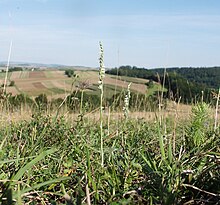
The Rieskessel is mainly used for agriculture and is only sparsely forested. In contrast, the edge of the Ries is lined with larger forest areas .
flora
In the southern and western Ries there are several smaller and larger heather areas , some of which are characterized by juniper . Several of these heaths are designated as nature reserves . Typical plants here are the steppe fennel , more rarely the Karthauser carnation and the silver thistle . The autumn rootwort is very rarely found. Also rare is the burning bush , he is found only on the western Riesrand. A specialty in a beech forest on the eastern edge of the Ries is the great cartilage , which is rare in Germany and only occurs in large numbers in Main Franconia .
Since the beginning of the 1990s, some arable land has been extensively farmed through the Riesrand project . Typical plants have settled on these, for example summer adonis , brown monk's herb and the small mirror of women .
tourism
The Nördlinger Ries is a tourist center . On the one hand, the Nördlinger old town with its historical backdrop is an attraction for tourists, on the other hand, the Ries crater and the associated Nördlinger Rieskrater Museum . The City Museum Nördlingen and the Bavarian Railway Museum in Nördlingen as well as the Museum KulturLand Ries represent sights in the Ries. The Romantic Road crosses the Ries with the section Wallerstein - Nördlingen - Harburg , the Swabian Albstraße ends in Nördlingen. In addition, the Ries is also a local recreation area . The Ries is marketed for tourism via the Geopark Ries or the Donau-Ries holiday region.
Transport links
The federal highway 25 , which in this area forms a section of the Romantic Road , crosses the Ries in the course of Dinkelsbühl via Nördlingen to Donauwörth , the federal highway 466 in the course of Heidenheim an der Brenz via Nördlingen to Gunzenhausen , and the federal highway 29 ends, from Bopfingen coming, in Nördlingen. The federal motorway 7 ( Würzburg - Ulm ) runs about 10 km away on the western edge of the Ries.
The Augsburg – Nördlingen railway and the Stuttgart-Bad Cannstatt – Nördlingen railway , which are known today in the Ries area as the Riesbahn , run through the Ries . The former and today's Nördlingen – Gunzenhausen railway were part of the earlier Ludwig-Süd-Nord-Bahn , which opened in 1849, from Lindau to Hof. Then there is the still in the freight transport operated railway Nördlingen-Dombühl .
literature
geology
- Johannes Baier: 100 years of suevite (Ries impact crater, Germany) . In: Aufschluss , Volume 70 (3), Heidelberg 2019.
- Johannes Baier: Suevit - the "Schwabenstein" from the Nördlinger Ries . In: Fossils , Volume 35 (3), Wiebelsheim 2018.
- Johannes Baier: The importance of water during suevite formation (Ries impact, Germany) . In: Annual reports and communications of the Upper Rhine Geological Association, New Series. Volume 94, Stuttgart 2012, doi : 10.1127 / jmogv / 94/2012/55 .
- Johannes Baier: The ejection products of the Ries impact, Germany (= Documenta Naturae. Volume 162). Munich 2007, ISBN 978-3-86544-162-1 .
- Johannes Baier: On the origin and importance of the Ries ejection products for the impact mechanism. In: Annual reports and communications from the Upper Rhine Geological Association. 91, 2009, pp. 9-29, doi: 10.1127 / jmogv / 91/2009/9 .
- Johannes Baier & Volker J. Sach: Shatter-Cones from the impact craters Nördlinger Ries and Steinheimer Becken . In: Fossils , Volume 35 (2), Wiebelsheim 2018.
- G. Graup: Carbonate-silicate liquid immiscibility upon impact melting: Ries Crater, Germany . In: meteorite. Planet. Sci. Volume 34, Lawrence, Kansas 1999.
- G. Graup: Terrestrial chondrules, glass spherules and accretionary lapilli from the suevite, Ries crater, Germany . In: Earth Planet. Sci. Lett . Volume 55, Amsterdam, 1981.
- J. Kavasch: Ries meteorite crater . Auer-Verlag, Donauwörth 1985, ISBN 3-403-00663-8 .
- ET Chao, R. Hüttner, H. Schmidt-Kaler: Outcrops in the Ries meteorite crater . Bavarian Geological State Office, 1992.
- CR Mattmüller: Ries and Steinheimer Basin . Ferdinand Enke-Verlag, Stuttgart 1994, ISBN 3-432-25991-3 .
- G. Pösges, M. Schieber: The Rieskrater Museum Nördlingen. Museum guide and recommendations for planning a stay in the Ries. Dr. Friedrich Pfeil, Munich 2000, ISBN 3-931516-83-0 .
- R. Hüttner, H. Schmidt-Kaler: Geological map 1: 50000 Ries with brief explanations on the back . Bavarian Geological State Office, 1999 ( brief description with preview ).
- G. Arp: Sediments of the Ries Crater Lake (Miocene, Southern Germany) (PDF). In: Series of publications of the German Society for Geosciences. Volume 45, Hannover 2006, ISBN 3-932537-41-6 .
- Volker J. Sach: Radiant limestone (Shatter-Cones) from the Brock Horizon of the Upper Freshwater Molasse in Upper Swabia (Southwest Germany) - remote ejections of the Nördlinger-Ries impact. Munich 2014, ISBN 978-3-89937-175-8 .
- Volker J. Sach: A REUTER block from the Staigertobel near Weingarten - distant ejecta of the Nördlinger-Ries impact in the Middle Miocene. In: Oberschwaben Naturnah ( Annual Issue 2014), Bad Wurzach 2014, pp. 32–37, ISSN 1613-8082 .
- Volker J. Sach, Johannes Baier: New investigations on radiant limestone and shatter cones in sedimentary and crystalline rocks (Ries impact and Steinheim impact, Germany). Munich 2017, ISBN 978-3-89937-229-8 .
archeology
- Guide to prehistoric and prehistoric monuments. 40 Nördlingen - Bopfingen - Oettingen - Harburg Volumes I and II, Philipp von Zabern-Verlag, Mainz 1979.
- R. Krause: From the Ipf to the Goldberg. Archaeological hikes on the western edge of the Ries. Konrad Theiss-Verlag, Stuttgart 1992, ISBN 3-8062-1020-9 .
- Hans Frei, Günther Krahe: Archaeological walks in the Ries. 2nd, revised and improved edition. Konrad Theiss-Verlag, Stuttgart 1988, ISBN 3-8062-0568-X .
- F. Krippner: From inferno to cultural landscape: The prehistoric man in Nördlinger Ries Verlag Steinmeier, Nördlingen 2000, ISBN 3-927496-81-2 .
Culture and customs
- Albert Schlagbauer , Wulf-Dietrich Kavasch (ed.): Rieser biographies. Rieser Kulturtage Association, Nördlingen 1993, ISBN 3-923373-21-X .
- Friedrich GG Schmidt : The Rieser dialect. The dialect of a Swabian-Bavarian-Franconian mixed area. Munich 1898.
- Rieser Heimatbuch. Published by the Society for Public Education in Nördlingen. CH Beck'sche Verlagsbuchhandlung Oskar Beck, Munich 1922.
Environment, nature
- R. Fischer: Flora des Rieses. Rieser Kulturtage publishing house, Nördlingen 2002, ISBN 3-923373-53-8 .
fiction
- Ronald Hummel : The legacy of the comet . Self-published, Nördlingen 2000.
Web links
- Nördlinger Ries in the Earth Impact Database
- Impact structure Nördlinger Ries on Stromboli online
- Description of the Ofnethöhlen
- Find Nördlinger Ries
- Ries cultural landscape
- Information on the Ries Krater Museum
- Bavaria's super crater
Individual evidence
- ↑ Federal Agency for Nature Conservation: Landscape profile 10300 Ries ( Memento from April 19, 2014 in the Internet Archive )
- ^ Franz Tichy: Geographical land survey: The natural space units on sheet 172 Nuremberg. Federal Institute for Regional Studies, Bad Godesberg 1973. Online map (PDF; 4.0 MB)
- ↑ Map of the natural space main units and natural space units in Bavaria Bavarian State Office for the Environment
- ↑ Biogeographical regions and natural spatial main units of Germany's Federal Agency for Nature Conservation
- ↑ a b Udo Kindermann : On the name "Ries" . In: Geological sheets for northeast Bavaria and neighboring areas . tape 23 , 1973, p. 128-131 .
- ^ J. Kavasch: Meteorite crater Ries . Auer Verlag, Donauwörth 1985, ISBN 3-403-00663-8 .
- ^ CW Gümbel: About the Ries volcano and about volcanic phenomena in the Ries basin . In: Meeting reports of the math.-phys. Class of the Bavarian Academy of Sciences . Munich 1870.
- ↑ W. Branco, E. Fraas: The volcanic Ries near Nördlingen in its importance for questions of general geology . In: Treatises of the Royal Prussian Academy of Sciences . Berlin 1901.
- ^ W. Kranz: Injection and explosion or just explosion in the volcanic Ries near Nördlingen and in the Steinheim basin? In: Journal of the German Geological Society . tape 66 . Berlin 1914.
- ↑ C. Deffner: The book mountain near Bopfingen . In: Annual books of the Association for Patriotic Natural History in Württemberg . tape 26 . Stuttgart 1870.
- ↑ E. Werner: The Ries in the Swabian-Franconian Alb . In: Leaves of the Swabian Alb Association . tape 16/5 . Tubingen 1904.
- ^ O. Stutzer: "Meteor Crater" (Arizona) and Nördlinger Ries . In: Journal of the German Geological Society . tape 88 . Berlin 1936.
- ^ EM Shoemaker, ECT Chao: New evidence for the impact origin of the Ries basin, Bavaria, Germany . In: Journal of Geophysical Research . tape 66 , no. 10 , 1961, pp. 3371-3378 , doi : 10.1029 / JZ066i010p03371 .
- ↑ Elmar Buchner, Winfried H. Schwarz, Martin Schmieder, Mario Trieloff: Establishing a 14.6 ± 0.2 Ma age for the Nördlinger Ries impact (Germany) - A prime example for concordant isotopic ages from various dating materials . In: Meteoritics & Planetary Science . 45, No. 4, July 2010, pp. 662-674. doi : 10.1111 / j.1945-5100.2010.01046.x .
- ↑ D. Stöffler, NA Artemieva, E. Pierazzo : Modeling the Ries-Steinheim impact event and the formation of the moldavite strewn field . In: Meteoritics & Planetary Science , Journal of the Meteoritical Society . No. 37 , 2002, ISSN 1086-9379 , pp. 1893–1907 , bibcode : 2002M & PS ... 37.1893S .
- ↑ Drill cores of inestimable importance . In: Augsburger Allgemeine , January 25, 2014.
- ^ Bavarian State Office for the Environment: One blow! - Debris from Wengenhausen . In: Hundred Masterpieces - The Most Beautiful Geotopes in Bavaria . Augsburg 2012, ISBN 978-3-936385-89-2 , pp. 164f.
- ↑ Bavarian State Office for the Environment: Alb dream! Schwabenstein near the Aumühle . In: Hundred Masterpieces - The Most Beautiful Geotopes in Bavaria . Augsburg 2012, ISBN 978-3-936385-89-2 , p. 166 f.
- ↑ Bavarian State Office for the Environment: Totally ver (k) algt! Riesseekalke in Hainsfarth . In: Hundred Masterpieces - The Most Beautiful Geotopes in Bavaria . Augsburg 2012, ISBN 978-3-936385-89-2 , p. 168 f.
- ↑ Stefan Glaser: Craters, glasses, debris - the meteorite crater "Nördlinger Ries" . In: Ernst-Rüdiger Look, Ludger Feldmann (Ed.): Fascination Geology. The important geotopes of Germany . E. Schweizerbart'sche Verlagsbuchhandlung, Stuttgart 2006, ISBN 3-510-65219-3 , pp. 140 f.
- ^ Lfu.bayern.de: Historical cultural landscape in the Nördlinger Ries - survey form cultural landscape elements
- ↑ Rieser Heimatlied (Friedrich Völklein)
- ↑ Song of the Bars (Friedrich Walter)
- ↑ Stadtmauerfest Liedgut from Nördlingen and the Ries on stadtmauerfest.blogspot.com
- ^ Association Rieser Kulturtage - "About Us" , accessed on January 27, 2019
